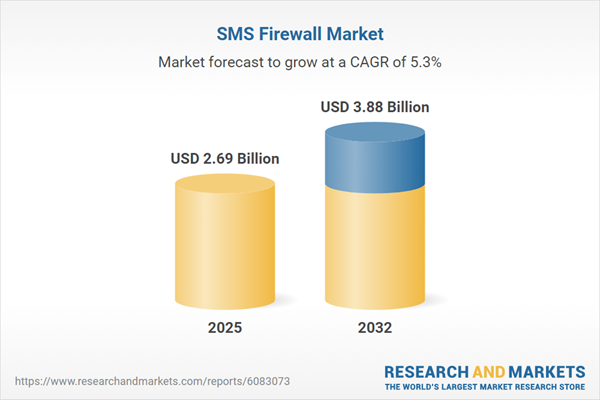Speak directly to the analyst to clarify any post sales queries you may have.
Senior decision-makers operating in dynamic enterprise environments recognize that secure, compliant mobile communications are vital. The SMS firewall market supports organizations advancing their messaging capabilities, providing essential defense against rising threats while enabling compliance and agility across digital ecosystems.
SMS Firewall Market Snapshot
The SMS firewall market grew from USD 2.56 billion in 2024 to USD 2.69 billion in 2025, registering a compound annual growth rate (CAGR) of 5.33%. Continued expansion is anticipated to reach USD 3.88 billion by 2032. This trajectory reflects heightened enterprise concerns over messaging security, increased regulatory complexity, and widespread adoption of cloud and hybrid network models. Market leaders have introduced advanced analytics and modular integration features that support high agility and consistent protection within varied enterprise messaging environments. These innovations facilitate responsive compliance strategies and robust security postures amid shifting global digital communication risks.
Scope & Segmentation
The report provides comprehensive coverage of the SMS firewall market, analyzing crucial business and technology drivers for organizations across all major industries and geographies. Key segmentation highlights include:
- Component: Service models such as managed and professional options, alongside modular solution sets, enable organizations to tailor infrastructure and support to unique business requirements.
- Deployment Mode: Flexible options include cloud configurations—hybrid, private (both multi-tenant and single tenant), and public—and on-premises deployments ranging from physical to virtual environments to match varying security and scalability needs.
- Organization Size: Large enterprises (Tier 1 and Tier 2) as well as small and medium enterprises benefit from targeted solutions aligned to their operational scale and cost-efficiency imperatives.
- End User: Vertical-specific trends and priorities are examined for sectors such as BFSI, government and public sector, healthcare, IT and telecommunication, and retail and e-commerce, with a focus on compliance pressures and transaction volumes.
- Regional Coverage: The market’s dynamics are analyzed across the Americas, Europe, Middle East & Africa, and Asia-Pacific, accounting for differences in cybersecurity maturity and local legal mandates.
- Notable Vendors: Innovation leaders profiled include Huawei Technologies Co., Ltd., Nokia Corporation, Ericsson AB, Amdocs Limited, Cisco Systems, Inc., Tata Communications Limited, Syniverse Technologies, LLC, Sinch AB, Infobip Ltd., and Route Mobile Limited.
Key Takeaways for Senior Decision-Makers
- Enterprises must evolve security architectures to counteract intensified messaging threats, such as phishing and large-scale spam, by implementing layered validation and compliance protocols.
- Cloud-native and hybrid deployments support real-time inspection and compliance, enabling secure growth of digital transactions and identity authentication processes.
- Integrating machine learning and behavioral analytics enhances early detection of malicious activity, which is essential for protecting customer trust and safeguarding reputation.
- Regional regulations necessitate tailored firewall strategies; modular, open API-based solutions streamline integration into evolving security frameworks and diverse digital platforms.
- Vendors continue to prioritize automation, scalable analytics, and improved visibility, equipping organizations with greater deployment agility and more effective fraud mitigation tools.
Tariff Impact and Strategic Procurement Considerations
Current United States tariffs on telecommunication hardware are influencing SMS firewall procurement decisions by introducing new cost dynamics. Organizations are increasingly pivoting to cloud-based and virtualized solutions to minimize hardware-related expenses. Multi-cloud and private cloud strategies, complemented by service-based procurement models, foster greater flexibility and cost management. These shifts are impacting supplier engagement, extending asset refresh cycles, and prompting enterprises to reevaluate architectural approaches to achieve both economic and risk-management objectives.
Methodology & Data Sources
This report applies a multi-phase research methodology, combining interviews with network security architects, telecom product managers, and carrier operators, validated by secondary analysis of regulatory documents and vendor literature. Rigorous data triangulation, expert panel review, and analytical tools such as SWOT, PEST, Porter’s Five Forces, and detailed market segmentation drive the accuracy and relevance of findings.
Why This Report Matters
- Senior decision-makers and security leaders can benchmark strategies using regional and compliance-focused insights grounded in robust methodologies.
- The report breaks down evolving market dynamics and technology trends, offering practical steps for procurement, risk mitigation, and solution alignment across enterprise architectures.
- Guidance on supplier evaluation, security optimization, and integration supports improved decision-making throughout the messaging security lifecycle.
Conclusion
SMS firewall solutions are enabling organizations to proactively address emerging threats and adapt to regulatory changes. Investing in these adaptable and analytics-driven platforms enhances enterprise resilience and ensures mobile communications remain secure, responsive, and aligned with business goals.
Table of Contents
3. Executive Summary
4. Market Overview
7. Cumulative Impact of Artificial Intelligence 2025
Companies Mentioned
The companies profiled in this SMS Firewall market report include:- Huawei Technologies Co., Ltd.
- Nokia Corporation
- Ericsson AB
- Amdocs Limited
- Cisco Systems, Inc.
- Tata Communications Limited
- Syniverse Technologies, LLC
- Sinch AB
- Infobip Ltd.
- Route Mobile Limited
Table Information
| Report Attribute | Details |
|---|---|
| No. of Pages | 199 |
| Published | October 2025 |
| Forecast Period | 2025 - 2032 |
| Estimated Market Value ( USD | $ 2.69 Billion |
| Forecasted Market Value ( USD | $ 3.88 Billion |
| Compound Annual Growth Rate | 5.3% |
| Regions Covered | Global |
| No. of Companies Mentioned | 11 |









